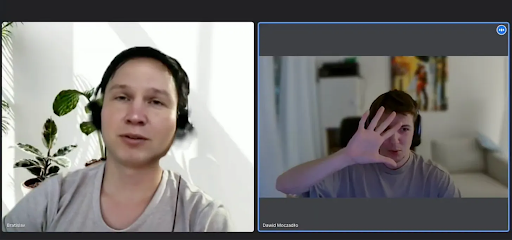Recently, one of our engineering leaders was interviewing a candidate for a job posting. We specifically required that the candidate be located in Latin America, and the candidate claimed to be a Brazilian in Brazil. While we are accustomed to speaking with non-native English speakers, their accent didn’t align with what we typically hear from Brazilian candidates. Also, they did not turn on their camera.
When the candidate reluctantly acquiesced to the request to come on-screen, my colleague noticed that it was dark outside — even though it was daytime in Brazil.
Although it’s difficult to confirm with fully remote workers, this person was most likely not where they claimed to be, nor who they claimed to be. This is an increasingly common trap when interviewing remote workers, and AI is only making it worse.
Horror stories
Perhaps you have seen the image below of a job candidate using AI to fake their appearance?
A detailed post by The Pragmatic Engineer describes how a tech interviewer identified a candidate faking their visual appearance using AI during a live interview. The candidate used AI to superimpose another face over their own, but it was not convincing due to subtle cues like limited head movement, unnatural blinking, and occasional video blurring which reveal the deception. Sensing something was off, the interviewer asked the candidate to hold their hand in front of their face—a common trick to expose AI-generated visuals. When the candidate refused, it confirmed the interviewer’s suspicions.
Stories like this are becoming more and more common, and we’ve encountered it in our own interviewing practices at AgilityFeat. Another colleague told me a story of how he suspected that a job candidate was using Speech to Text in a job interview to take his questions, convert them to text in real-time, and feed them into an LLM like ChatGPT in order to get an answer.
How could he tell this was being done? The job candidate’s eyes were darting to a second screen and would awkwardly delay his answers while waiting for the LLM to process the response.
Tips for detecting AI is being used by a candidate
Broadly speaking, there are two ways AI might be used dishonestly in a job interview:
- Faking identity (or appearance)
- Faking level of knowledge or expertise
Here are some tips for detecting the use of AI in each case, based on our own experience as well as a few of the many articles out there on this topic.
Stopping Identity Fakes in Interviews
- Require that cameras are turned on.
- If anything about the candidate’s appearance feels “off” to you, ask them to turn their head side to side and then raise their hand in front of their face. Ensure that doing so does not cause a significant change in their appearance which would indicate AI is being used to alter their face.
- Confirm that the face of the person you are speaking with matches social media profiles that were supplied with the CV.
- Ask them to show you their national identity card with their photo and name and confirm it matches other information they have shared already on their CV or job application.
- Pay attention to body language and lip movements. Do they match what is being said?
- Are they blinking fast or slow in an unnatural way? Is there an unnatural lack of eye movement or facial expression?
- Does the audio seem to match what you see in the video? Is it synchronized with the person and does the background noise match their environment?
- Ask questions about their region. Where is their favorite place to eat? What do they like best about their city? Act interested, as if you were going to travel there yourself. You can even ask them to send you a link to a local business or restaurant that they like. Double check that it is a real business, and ask follow up questions that show they actually know the place.
Stopping Knowledge Fakes in Interviews
- Require that cameras are on. Ask the candidate to look at you as they answer questions. Be explicit that you are asking them to do this so that you can see they are not looking at a second screen for answers.
- Watch out for regular pauses in the conversation while they wait for an LLM to provide answers.
- If you get signals they may be using other devices to assist them, ask them to hold their hands up during some answers to ensure they are not typing or using their mouse to engage with an LLM.
- Get them to tell relevant stories about projects they worked on. The best defense against AI is to get them talking about specific projects listed on their CV.
- Ask them to share their screen to show you something about a project or client, even if it’s simple. (“Can you bring up this repo in your public github repository? I want you to share it on the screen with me and talk me through it”)
- When doing a coding interview with candidates, ask follow up questions on their code which will force them to answer quickly without the aid of an LLM or other tool.
What drives AI-faked interviews?
Faking your appearance, accent, and/or knowledge is a lot of work for a job candidate to go through–especially to get a job where they would likely fail to meet expectations and get fired anyways! So why do they do it?
They may simply hope to fly under the radar. Or, assume they can continue to fake their work with the help of AI. They may legitimately be qualified for the job, but not meet other requirements, like geographic location.
Some even speculate fake candidates are deliberate and malicious attempts by cyber terrorists or dangerous nation states to hack companies from the inside, or simply to cause chaos in the global economy.
AI fakes should not prevent remote hiring
Regardless of the reason, fake interviews happen enough in 2025 that companies have to worry about it. It’s even causing some companies to discard remote work altogether. Their assumption is that the only way to truly prevent AI fakers is to require in person interviews and in-office work. It also fits nicely into a preferred storyline for some companies who want to enforce Return To Office (RTO) policies.
However, these reactionary policies exacerbate as many problems as they solve, including talent shortages, reduced talent pools, and increased costs.
Remote hiring presents many opportunities for US companies, especially when they look toward nearshoring in Latin America, which has a large pool of top talent, with great communication skills, same time zone collaboration, and lower costs. These benefits have led to double digit growth in hiring in many Latin American countries in 2024, including a 55% growth rate in Colombia hiring, according to Deel’s Global Hiring Report.
How working with AgilityFeat reduces your risk
Remote teams help you tap into larger global talent pools and reduce costs. But how can you ensure you are hiring the right talent, in the right places, and that they are the real humans they say they are? In other words, how do you get the best of both worlds?
This is where our nearshore staff augmentation services and our Build-Operate-Transfer (BOT) model provide the perfect blend for US companies. We can help you mitigate the risk of remote hires while also providing the easier hiring and reduced costs that you need to maintain competitive advantage.
- We reduce your interview burden. Job postings these days often get hundreds if not thousands of applicants, many without any regard to meeting the actual qualifications listed in the job posting. Sorting through them and holding initial screening interviews can take hundreds of hours of work. Many companies rely on their development teams to help decide who to interview, and that takes them away from valuable project work. Our team has the tech and the HR expertise to handle all the candidate screening for you. In the course of doing that, we filter out not only who is a real human and who is improperly aided by AI, but identify the best finalists for you to interview.
- We provide pre-vetted candidates (real humans!) tailored to your needs. Each job search that we do for a client is tailored to their unique needs. We are on the lookout for the specific technical and industry experience you desire, as well as other softer skills like communication and collaboration skills, and culture fit. We can also apply technical tests to candidates, including coding challenges.
- We save you time and money. If and when we receive fake AI candidates, we will be the ones losing time figuring that out, instead of your team. We save your team hundreds of hours of work and months of candidate screening and interviewing time, reducing hiring searches from months to weeks. This saves you tens of thousands of dollars across your team in time savings and frees them up to work on your product priorities.
Further reading: In-Demand Tech Roles: AgilityFeat’s Most Placed Talent
A Latin American subsidiary is the perfect balance of risk and cost reduction
In addition to our normal recruiting process, our Build-Operate-Transfer (BOT) model can help further reduce your risk with remote teams. It is, in fact, a perfect solution for the concerns raised in this blog post.
In the BOT model, we set up a subsidiary business for you in Colombia, in parallel to doing interviewing and hiring for your custom technical team. After the subsidiary is operational to your specifications and your team has been working successfully for you through that subsidiary, we sell the operation back to you for a very affordable, pre-negotiated price. We take on all the legal and operational risk and bureaucracy associated with setting up that subsidiary for you, based on our own experience and our network of lawyers and accountants in Colombia.
Further reading: Colombia: An Ideal Nearshore Hub for US Companies
The end result is that instead of having a dispersed technical team across many countries in Latin America or globally, your team all works in a single large tech city like Bogotá or Medellín in Colombia. After we have sold the subsidiary to you, your operational costs will go down further from the staff augmentation model, enabling you to have team members at up to 60% off typical US salaries.
This offers a number of business benefits, including some which address the fears around faked AI candidates.
- In Person Interviews. Our team in Colombia can conduct final in person interviews on your behalf, ensuring that the candidate can show up in person in Bogotá or Medellín, and conduct themselves with the same professionalism and quality that we saw in prior video interviews.
- On Site Work Locations. “Return To Office” does not mean they have to be in your US office! As part of the BOT model, we can establish a brick and mortar office for you which is controlled by your Colombian subsidiary and managed by us until you are ready to take it over. Office space is very affordable in Colombia and will include high speed internet and other amenities you would see in a US office.
- Enforced Corporate Security. If your security policy requires things like background checks or controlled network access, as well as legally binding employee agreements around confidentiality and data protection, the BOT model makes that much easier. Instead of worrying about remote team members spread across multiple countries, you can use a single set of legal documents and enforce policies for in-office or hybrid workforces in Colombia.
- Device Control. Shipping corporate laptops to dispersed team members is a real pain and very expensive! We know because we’ve helped clients with that in the past. In fact, clients with strict device policies is one of the things that inspired us to offer a BOT model.
- Ease of Travel. Having your international remote team in a single country makes it much easier for you to visit them! Bogotá and Medellín are both fun cities to visit, and easy to travel from the US. Your leadership or engineering team will be able to do on-sites with ease. We’ll be happy to help you coordinate your initial visits, with our team as hosts.
Reach out for a free assessment
The AI revolution has created many opportunities, as well as challenges, to the modern workforce. AI faked interviews are certainly one of the unwelcome problems. But don’t let your fear of that prevent you from taking advantage of the many benefits and opportunities that a remote workforce in Latin America provides.
Our team at AgilityFeat absorbs the risk and hassle of screening hundreds of Latin American tech applicants for the best (and most human!) candidates available for your key technical positions. On top of that highly specialized recruiting process, we can also help you create a scalable and sustainable operation in Colombia that will ensure you can meet all of the security requirements your company has. And with no AI fakes allowed!
Contact us for a free assessment of how you can save money and leverage the incredible technical talent that Latin America has to offer.











